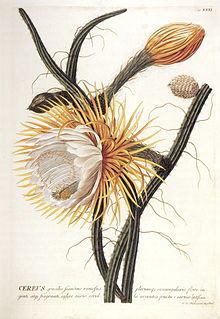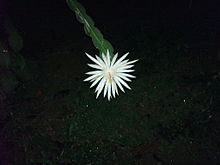- Selenicereus grandiflorus
-
Queen of the Night 
Scientific classification Kingdom: Plantae (unranked): Angiosperms (unranked): Eudicots (unranked): Core eudicots Order: Caryophyllales Family: Cactaceae Subfamily: Cactoideae Tribe: Hylocereeae Genus: Selenicereus Species: S. grandiflorus Binomial name Selenicereus grandiflorus
(L.) Britton & Rose, (1909) Contr. US Nat. Herb. 2:430Synonyms Cactus grandiflorus L. (1753) Sp. Pl. 467
Cereus donkelaarii Salm-Dyck Allg. Gartenz. xiii.
Cereus grandiflorus (L.) Mill. (1768) Gard. Dict. ed. 8, no 11
Cereus grandiflorus affinis Salm-Dyck (1850) Cact. Hort. Dyck. 1849:51, 216
Cereus grandiflorus var. spectabilis Karwinsky in Förster (1846) Handb.Cact. 415
Cereus scandens minor Boerhaave in Arendt (1891) Monatsschr. Kakteenk. 1:82
Cereus schmidtii (1894) Monatsschr. Kakteenk. 4:189
Cereus grandiflorus var. minor Salm-Dyck
Cereus tellii hort. in Hildmann (1895) Monatsschr. Kakt. 5:43
Cereus grandiflorus var. haitiensis (1903) Monatsschr. Kakteenk. 13:183
Cereus hondurensis K. Schumann in Weingart (1904) Monatsschr. Kakteenk. 14:147
Cereus grandiflorus uranos Riccobono (1909) Boo. R. Ort. Bot. Palermo 8:249
Selenicereus donkelaarii (Salm-Dyck) Britton & Rose (1917) Standard Cycl. Hortic. 3141
Selenicereus grandiflorus var. affinis (Salm-Dyck) Borg (1951) Cacti 206
Selenicereus grandiflorus var. tellii (hort. ex Riccobono) Borg (1951) Cacti 206
Selenicereus grandiflorus var. uranos (Riccobono) Borg (1951) 206
Cereus uranos hort.
Selenicereus hondurensis (K. Schumann) Britton & Rose (1909) Contr. US. Nat Herb. 12:430Selenicereus grandiflorus is a cactus species originating from the Antilles, Mexico and Central America. The species is commonly referred to as Nightblooming Cereus, Queen of the Night (though these two terms are also used for other species), Large-flowered Cactus, Sweet-Scented Cactus or Vanilla Cactus. The true species is extremely rare in cultivation. Most of the plants under this name belong to other species or hybrids.
Contents
Common names
- Afrikaans: Koningin van die Nag
- Chinese:Tan Hua (昙花)
- Danish: Nattens Dronning
- Dutch: Koningin van de Nacht
- English: Queen of the Night, Night-blooming Cereus, Large-flowering Cactus, Sweet-scented Cactus, Vanilla Cactus, Lunar Flower, Large Blooming Cereus, Large flowered torch thistle, Large-flowered Night Cactus
- Estonian: Öökuninganna
- Finnish: Yönkuningatar
- French: reine de la nuit, princesse de la nuit, cierge a grande fleurs, vierge a grandes fleurs, Cierge rampant à grandes fleurs, Fleur d'amour
- German: Königin der Nacht, Schlangencereus, Schlangenkaktus
- Italian: cacto grandifloro, regina della notte
- Japanese: Gekka Bijin (Beautiful woman under the moon)
- Malayalam: Nisha Ghanthi(Nishagandhi)(Fragrance of the Night). This name is also used for Epiphyllum oxypetalum.
- Portuguese: flor-de-baile, cardeiro trepador
- Română: Cactus din Antilele Olandeze
- Sinhala: Kadupul (කඩුපුල්)
- Spanish: Reina de las Flores, Reina Gigante, Cardon, Gigante, Organillo, Reina de la noche.
- Swedish: nattens drottning
- Tamil/Telugu : Brahma Kamalam (Lord Bhrahma's Flower)
- Kannada: Brahma Kamala
- Arabic: Laylat al-Qadr (ليلة القدر)Al-Qadr (sura) 'The Night of Power' referring to a holy event in Islam
Etymology
Grandiflorus (Lat.) = large flowered. When Carl von Linné descripted this cacti in 1753 it was the largest flowered species of cacti known. Paradoxically, are moderate in size compared with several other Selenicereus species.
History
The first species to be brought into cultivation. Linné (Linnaeus) descripted it in 1753, but it was known long before. Records from Hortus Kewensis gives that the species was grown at Royal Gardens at Hampton Court before 1700. There has been doubt about which plant was available to Linné when he drew up his description, but this is solved and both the plates on this side show the authentic species.
Origin and habitat
Greater Antilles (Cuba, Cayman Islands, Puerto Rico, Jamaica & Haiti), Mexico, Guatemala, Belize, Honduras, Nicaragua, and a few other locations in South and Central America. Climbing on trees and on rocks. 700m alt. Extremely variable, especially in Jamaica, stems with slightly wavy to strongly knobby margins occurs in the same plant. Much confused in cultivation. Many species of Selenicereus should be reduced to synonyms of subspecies of this species, differing merely in degree rather than in kind.
Cultivation
An easily cultivated, fast growing epiphyte or lithophytic plant. Needs a compost containing plenty of humus and sufficient moisture in summer. Should not be kept under 5°C (41°F) in winter. Perform best if grown in full sun. Extra light in the early spring will stimulate budding. Flowers in late spring or early summer, only blooms one night a year or several years and withers within hours.
Description
The bloom and wither of a Selenicereus grandiflorus (time-lapse)
Stems scandent, clambering or sprawling, branching, sometimes forming tangles, producing aerial roots, stiff, to 10m long or more, (10)15-25(-30)mm thick; ribs (4-)7-8(-10), low, less so on older branches, separated by broad, rounded intervals, slightly wavy to strongly knobby; areoles small, wool white or greyish white, internodes (6-)12-20mm; spines 5-18, to 4,5-12mm, basally ca 0,25mm in Ø, acicular, elliptic or circular in cross section, bulbous basally, spreading, yellowish brown to brownish or yellow, grey in age, eventually deciduous hairs from lower part of areole ± numerous white or brownish, mature vegetative areoles usually lacking hairs, juveline plants have spines shorter and fewer; epidermis glaucous green or bluish green, often ± purplish, smooth. Flowers 17-22,5 cm long, fragrant reminding or vanilla and orange-flower; pericarpel 25mm long, with bracteoles 5mm, strap-shaped and yellowish, covered with nearly white or tawny hairs and sharp bristles; receptacle 7,5-8,7 cm, bracteoles 5-14mm, strap-shaped to linear, yellowish with long, nearly white or tawny, wavy hairs and sharp bristles in their axils, ca 25mm long; outer tepals 7,5–10 cm long, averaging 4,5mm wide, linear-attenuate, light brown, salmon to pink buff, yellowish adaxially; inner tepals 7,5–10 cm long, 9- 12(-15)mm, shorter than outer tepals, wide, lanceolate, gradually narrowed into a pointed or acute apex, white; stamens 38-50mm long, delinate, white, anthers 1,5mm long, yellowish; style 15–20 cm long, often longer than inner tepals, 1,5mm greatest Ø, stigma lobes 7-12, ca 7,5mm long, slender. Fruit ovoid, 5–9 cm long, 4,5–7 cm thick, whitish, partly pink, pink, yellow or orange, covered with clusters of spines and hairs which soon drop off, juicy, the imbilicus small and inconspicuous. Four subspecies are recognized:
-
- ssp. donkelaarii (Salm-Dyck) Ralf Bauer
- ssp. grandiflorus
- ssp. hondurensis (K.Schum. ex Weing.) Ralf Bauer
- ssp. lautneri Ralf Bauer
Hybrids
Selenicereus ×callianthus (Gaillard) Lindinger (1942). This is a hybrid between this species and Selenicereus pteranthus. Many plants under the name Selenicereus grandiflorus may belong to this cross. It is very similar to Selenicereus pteranthus, but stems more slender and spines, longer and yellowish.
See also
- Bahamian dry forests
- Night blooming cereus - for other cacti sharing this name
- Arizona queen of the night
External links
- Night-blooming cereus. Cereus grandiflorus (L)
- Selenicereus grandiflorus Picture
- Selenicereus grandiflorus Pictures and time lapse movie of opening flower
- desert-tropicals.com: Selenicereus
Categories:- Selenicereus
- Night-blooming plants
- Cacti of Mexico
- Flora of the Bahamas
- Flora of the Caribbean
- Flora of the Yucatán
- Flora of Central America
- Medicinal plants
- Garden plants of Central America
- Epiphytes
Wikimedia Foundation. 2010.

